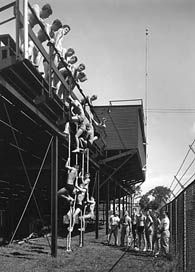Scene Again
July 1943: The Navy arrives
Having trouble comprehending the scope of the Navy V-12 program in World War II? Then try a thought experiment, says V-12 veteran Dana Smith of Tenants Harbor.
Imagine you’re a student returning to Bates after summer break. You walk onto a campus where the enrollment is still the same as before break, but now every other student is a Navy man on active duty, in uniform.

V-12 seamen scale ropes behind the Garcelon Field grandstand in summer 1943.
In effect, that’s what happened 60 years ago, when the Navy dropped battalion-size units onto 131 U.S. college campuses, including Bates, where these “apprentice seamen” got officer training and accelerated college instruction.
At Bates, the trainees included enlisted men who’d already seen action in the Pacific alongside recent high school grads who thought a train trip from Rhode Island to Maine was a big deal. Other trainees had tasted a year or two of college life at in-state rivals like Colby, Bowdoin, or UMaine, at small colleges like Middlebury or Haverford, at the Ivies, or at large and small schools like Syracuse or Virginia State College for Negroes.
By the winter of 1944-45, the V-12 influx had bolstered the Bates enrollment, which had been decimated by the war, back to its typical, pre-war number of about 700. More than half the students (340 of 701) were V-12 participants, including Bobby Kennedy, from Harvard. Civilian male students alongside military men created a wary atmosphere.”
Then came room inspection and standing to morning colors in front of Hathorn, followed by classes alongside civilian male and female students. Workouts included rope climbing (pictured here behind the Garcelon Field grandstand), which was part of a “Commando” obstacle course. Then there were the minor nuisances of military life: “Got another inoculation yesterday and do not feel very well today,” Dana Smith wrote in a letter home to Hollis Center.
Today, Smith helps the Bates V-12 group keep in contact. For the last two years the former Navy men have held their annual V-12 luncheon at the College in the Muskie Archives. “I think that most men with military experience reach a point where they would like to reconnect with the fellows they served with,” Smith says. “Sharing that common experience, whatever form it took, is a magnet.”